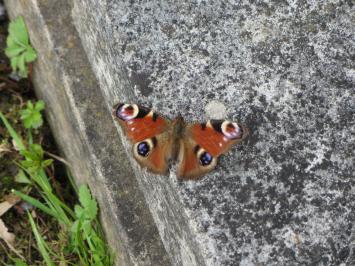
©Carole Tyrrell
On my previous spring saunters I’ve wandered through two of London’s large, sprawling cemeteries; Kensal Green and West Norwood but this year I thought I’d stay nearer to home. St Nicholas is my local church and within walking distance of my home. It’s in a prominent position in the town as it’s at the top of the hill and opposite the entrance to Knole Park, another local landmark. One of its most famous Rectors was the preacher and poet, John Donne, who was in post from 1616 until 1631 and is commemorated with a metal plate on the pavement outside. Every time I visit its churchyard I find something new and at a time when Nature is beginning to awaken again what better excuse did I need?
The present building’s shape dates from the 13th century and in fact the present nave dates from 1270. It replaces an earlier church. The north aisle was added in 1320 and the chancel south aisle and tower around 1450. There have been many later alterations but the basic 15th century structure and style remains. In 1995 excavations took place to create more meeting rooms in what may have been the crypt. The interior of the church has some monuments dedicated to prominent local families.
But it’s the churchyard that fascinated me. Intertwined with plain Victorian headstones are some wonderful examples of 18th century tombstones adorned with memento mori. A couple are naively executed but others are finely carved with the wonderful 18th century calligraphy accompanying them.
The Spring sunlight illuminated the thick patches of moss and lichens that had carefully draped itself over the monuments and memorials. It made the subtle hues and shades really stand out; the combination of green and gold or browns seemed to gleam amongst more subtle hints.
Some of the lichens looked as if someone had taken a paintbrush loaded with colour and then dabbed it onto the stones. Moss has the effect of softening the edges of stones and letters and, where it replaces letters completely, gives a more organic feel to the epitaph.
A spreading horse chestnut tree was laden with sticky buds already beginning to burst into leaf. ‘How many years has it stood near the church door marking the seasons and years?’ I thought.

©Carole Tyrrell
A chaffinch called loudly for its mate from the closed part of the churchyard. I had explored this in October and seen its large carpet of prickly sweet chestnuts as a fox had turned tail and run back to where it had come from. There has been a piece of bone abandoned on top of a flat headstone and I hoped that the fox had brought it in from a nearby butchers rubbish bin…….now alas this part of the churchyard is closed due to Health and Safety as it’s so overgrown. On this visit I disturbed a fluffy ginger and white cat who soon fled in the same direction as the fox.

©Carole Tyrrell
Three large patches of snowdrops clustered protectively around the base of a tree, their pristine heads nodding in the breeze as if deep in conversation. Primroses had begun to stud the grass and I saw my first ever cowslip amid headstones.
The tiny bright blue flowers of Speedwell blossomed beside a small tombstone and a red-tailed bee, one of the first signs of Spring, buzzed along the top of the grass. Dog violets, a much underrated flowers in my opinion, frothed plentifully beside the iron entrance gate.
Nearby, was not so much a carpet of Spring flowers, but more of a small rug of them. More Primroses, the bright yellow of Lesser Celandine, another harbinger of Spring, and more dog violets all combined to make a wonderful collection of green, yellow and purple.
There are some remarkable epitaphs in St Nicholas churchyard and this one which has now been incorporated into the fabric of the church caught my attention.
The epitaph reads:
To the Memory
of John Braithwaite Chief Coachman
to his Grace Lionel Duke of Dorset
He died by an unfortunate fall from
Ye coach near Riverhead in this parish.
His loss was greatly lamented
and by none more than
by his Lord and Master
to whom he was a most just and faithful servant
This sad accident happened
on the first day of July in
the year of our Lord 1723
With the Caring for God’s Acre project which is linked with the bio diversity recording site, irecord, biodiversity within cemeteries is being examined more closely. They are real havens for wildlife especially in big cities as they are an invaluable green space that’s accessible to everyone. I’ve always enjoyed exploring cemeteries partly for this reason whether it be standing waist high in wild flowers on a hot July day in the meadow at Kensal Green cemetery or counting butterflies along the side paths leading to the Courtoy Mausoleum in Brompton Cemetery.
Sadly the Spring sunshine was replaced by April showers but Mother Nature ignored this and kept bursting forth regardless. I’m already looking forward to my summer saunter within St Nicholas.
©Text and photos Carole Tyrrell
References and further reading
https://www.sevenoakssociety.co.uk/upper-high-street-west/255-st-nicholas-church






























































































